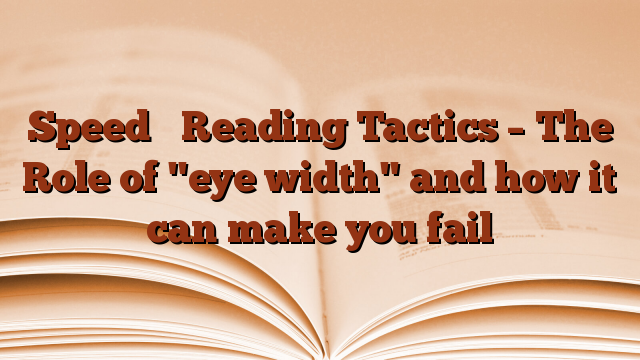When learning to read fast, the adage still applies that a little bit of information can be dangerous. Consider the term “eye span.” Although I’ve been teaching people from all walks of life to speed read for 30 years, it’s only recently that I’ve received many questions about it. For new learners coming into my programs, the question always comes up early in the training. I don’t even use the term in my training, the new learner read about it somewhere, but there are too many concerns.
“Eye span” refers to the amount of text someone’s eyes take in each time they stop or “fix” their eyes. By stating “eye span” someone has already done some research on speed reading. There is a lot of misinformation on the subject. It is true that part of the goal of fast reading is to allow the eyes to take in more each time the eyes stop (fixation). A conventional linear reader typically captures one to three words per fixation. This is inefficient when considering the full range of clear focus that the eyes have at normal reading distances. This normal field of view measures between one and three inches in diameter. Seeing is always dimensional – that is, there is both a horizontal and a vertical field.
The problem of speed reading and “eye span” is highlighted by marketing and the fact that many programs try to teach you to expand horizontal span. In fact, many programs, especially speed-reading software programs, train well beyond the natural limit of the viewing experience, which is about 3 inches, using only the horizontal field. These types of training exercises attempt to extend this span to 6 inches or more by telling the learner to walk straight down the page, one fixation per row, row by row.
Remember I pointed out that vision is dimensional? Try this experiment. Take a page that is mostly text, the printed area is six to eight inches, and has large paragraphs. Now focus your eyes somewhere in the middle of the text. Still close your eyes. Take a pen or pencil and draw a circle around the writing that you can see clearly. Don’t worry about understanding the text, just focus on the clarity of the viewing experience or how much you’re seeing. Measure the area. It’s probably somewhere between one and three inches in diameter. This is your natural “cone of vision”.
If you’re reading fast, try moving this “cone of vision” across the page and down. However, you shouldn’t worry about how many words you see. You want your mind to pick out the meaning of the text. However, without training the mind to respond to and understand these words that appear out of order, it will be quite frustrating because you don’t understand.
Please note that you cannot read if you do not understand. understanding is key. Understanding means giving meaning to what is printed. Too often I get learners who say they’ve learned to go through material at 1500-2500 words per minute, but they don’t get it. They’ve gone through the visual training, but not the cognitive training or understanding.
With this focus on “eye span” the learner worries too much about the technical aspects of the eyes or mechanics and forgets the meaning of the text. The mind becomes overloaded because there is competition for what the mind is doing. You can’t understand it if you’re so focused on the technical aspects of what the eyes are doing. So forget what your eyes are doing. Press the meaning!
In all our years of teaching speed reading, we teach learners to open up these 1-3 inches in diameter and look for chunks of ideas or meaningful phrases. It’s not about “groups of words,” “clusters of words,” or the number of words that matter. It is about focusing on “groups of meaning”. Speed reading is a process in which the reader seeks meaning from print in a more efficient manner. Eye span only plays a role in the reading process, but it gets almost all of the attention in most speed reading training sessions.
Thanks to Ed Caldwell | #Speed #Reading #Tactics #Role #quoteye #widthquot #fail

Leave a Reply